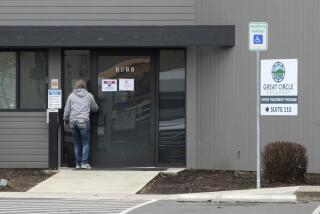Portable Offices Fuel Growth of Garden Spots
- Share via
Clad in shorts and tennis shoes, William Smith sits at his computer, his German shepherd curled at his feet and the Deschutes River gurgling through the pines just outside his window in Bend, Ore.
The blips on his screen still record the rise and fall of the stock market, and he still has plenty of clients, but he’s a long way from the buttoned-up office in Connecticut where his investment firm used to be.
Here, he’s just a few minutes from golf courses and a few more from mountain trails, trout lakes and ski slopes.
“I remember coming back from vacations saying, ‘Gee, I wish the vacation wasn’t over,’ ” Smith said. “Now we’re living where others are fortunate enough just to visit.
“This business is portable--we can live anywhere we want.”
A new wave of businesspeople whose livelihood depends on phones, faxes and computers is pulling up roots in big cities and putting them down in places where they’d really like to live.
The trend has helped make Bend--in central Oregon’s high desert known for its natural splendor--one of the fastest-growing cities in the nation. Between 1990 and 1997, Bend and surrounding Deschutes County grew by 34%, to just over 100,000 people. That’s three times the overall growth rate of Oregon.
That growth is being driven by affluent baby boomers and young retirees, many of whom get involved in the community and find themselves getting back into the businesses they left.
“We’re riding the crest of the baby boom,” said Robert Raimondi, the regional development officer for the Oregon Economic Development Department. “People who have reached a certain level are waking up one day and asking, ‘How long will I continue to live in a place where I don’t want to live just because I am making x amount of money?’ ”
Smith, who’s in his mid-50s, moved to Bend two years ago from Westport, Conn., following a search across the country for a place to retire. His wife, a stock analyst, fell in love with the mountains. His sons, ages 13 and 8, liked the idea of being able to snowboard every day of the year.
After several months in their new home, neighbors learned that Smith was a retired investment advisor and began asking him for tips. It happened so often that he and his wife decided to reopen their Zimbalist Smith Investments here. “I’m back by popular demand,” he said.
Most new businesses settling into Bend are high-tech and fairly small, and can ignore the lack of proximity to markets, natural resources, transportation and other factors that normally drive a business move.
Since most did business nationally or internationally to begin with, they can keep their old customers. Many executives interviewed said they did no business in the Bend area and some did none in Oregon.
“You can have a big-city career and live in a place like Bend,” said Greg Haugen of Advanced Power Technology Inc., which makes high-powered semiconductors and relocated here from the Silicon Valley in 1984. He followed a year later.
Executives in the summer are likely to be clad in shorts. Ties are scarce.
“But the business is ferociously competitive,” Haugen said. “There is a lot of recreation and it is laid-back, but we’re not looking for people who are ready to kick back and take it easy.”
Raimondi himself is a transplant, giving up the vice presidency of a Pennsylvania metals company to find a better quality of life.
His state development office, he said, “tries to give people a logical reason to make an emotional decision” to bring their businesses to central Oregon.
In many ways, central Oregon would seem to be lacking as a business location.
Infrastructure costs are cheaper over in the Willamette Valley and in the state’s major markets of Portland, Salem and Eugene. Freight in and out also is cheaper there.
“It is three hours to a large metropolitan area. Things are more expensive here. If you look at a Fortune 500-type of company seeking to relocate, we fall off of the list pretty fast,” Raimondi said. “Companies that move here are the ones in which the decision-maker lives with the decision. Most of them are high-tech.”
One analyst says a national labor shortage makes location all the more important: Businesses have to be in a place where people want to go.
“A good quality of life has a double-whammy effect,” said Ted Levine, chairman of the New York-based Development Counselors International, which recruits businesses for client regions.
“It attracts and recruits skilled workers who could get a good job anywhere but want to go where they want to be. And just as important, maybe even more important, it keeps workers where they are, and that very often is a part of economic development that is overlooked.”
Rena Bennett-Dellwo and her husband visited the area while on vacation. They returned to Minnesota, she recalled, to another winter of 40-below temperatures and made the move to Oregon a year ago.
Their engineering company, RBD, has since grown from four to eight employees.
“You take a chance,” she said. “Will your customers find you? Will they follow you?”
“We came here and fell in love,” she added. “There is so much to do here. The people are so nice.”
She said she is aware, however, of the dilemma the area finds itself in: being attractive because it is small, thus growing by the people it attracts.
The new companies tend to be clean and provide jobs, but more people “detract from that which attracts you,” she said. “Some of the people who have been here awhile are upset about the whole thing,” she said.
Nobody seems to want another Silicon Valley; in fact, some companies moved here from there to get away from the congestion and leakage of trade secrets.
Yet on the edge of Bend, the one-story clusters of quiet high-tech businesses are spreading, and there is talk already of a “Silicon Desert” developing amid the pine and juniper trees of central Oregon.
More to Read
Inside the business of entertainment
The Wide Shot brings you news, analysis and insights on everything from streaming wars to production — and what it all means for the future.
You may occasionally receive promotional content from the Los Angeles Times.










